
台北優人神鼓與嵩山少林寺武術館 U-Theatre


台北優人神鼓與嵩山少林寺武術館 U-Theatre
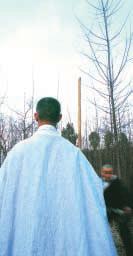
封面照片及上圖 Cover image and photograph above © 許斌
藝術總監/導演/編劇
劉若瑀
Artistic Director, Director and Scriptwriter Liu Ruo-yu
武術總策劃
Wushu Chief Producer
音樂總監
Music Director
製作及演出 Credits
角色 Cast
分場大綱 Synopsis
導演的話 Director’s Notes
武術總策劃的話 Wushu Chief Producer’s Notes
焦紅波
Jiao Hongbo
黃誌群
Huang Chih-chun
香港文化中心大劇院 Grand Theatre
Hong Kong Cultural Centre
演出長約 2 小時10 分鐘,包括一節 20 分鐘中場休息
音樂總監/作曲的話 Composer and Music Director’s Notes
劇團顧問的話 Company Consultant’s Notes
藝團介紹 Company Profiles
生平介紹 Biographies
Running time: approximately 2 hours and 10 minutes with a 20 minute interval
普通話演出,附中英文字幕 Performed in Putonghua with Chinese and English surtitles 23 - 27.2.2006
為了讓大家對這次演出留下美好印象,請切記在節目開始前關掉手錶、無㵟電話及傳呼 機的響鬧裝置。會場內請勿擅自攝影、錄音或錄影,亦不可飲食和吸煙,多謝合作。
To make this performance a pleasant experience for the artists and other members of the audience, PLEASE switch off your alarm watches, MOBILE PHONES and PAGERS. Eating and drinking, unauthorised photography and audio or video recording are forbidden in the auditorium. Thank you for your co-operation.
藝術總監 / 導演 / 編劇
劉若瑀
武術總策劃
焦紅波
音樂總監 / 作曲
黃誌群
演出
少林寺武術館
王雷軍(隊長)
史建虎
李朋
張小勇
柳雲南
蘇先武
趙永軍
杜光輝
黃元圓
史向前
冀永會
俞志超
郝漢
優表演藝術劇團
黃誌群
黃士芸
黃焜明
伊苞
黃依婷
黃伯倫
張雅倫
蘇盈慈
盧佳鈴
黃國忠
東冬.候溫 黃立
舞台設計 曾文通
燈光設計 馮國基
服裝設計 霍榮齡
舞台監督 黃諾行
燈光技術指導 李琬玲
音響技術指導 林盟祐
舞台技術指導 林世信
Artistic Director, Director and Scriptwriter
Liu Ruo-yu
Wushu Chief Producer
Jiao Hongbo
Music Director and Composer
Huang Chih-chun
Performers
Shaolin Temple Wushu Training Center
Wang Leijun (Team Leader)
Shi Jianhu
Li Peng
Zhang Xiaoyong
Liu Yunnan
Su Xianwu
Zhao Yongjun
Du Guanghui
Huang Yuanyuan
Shi Xiangqian
Ji Yonghui
Yu Zhichao
Hao Han
U-Theatre
Huang Chih-chun
Huang Chih-lin
Huang Kun-ming
I Bao
Huang I-ting
Huang Po-lun
Chang Ya-lun
Su Yin-tsu
Lu Chia-ling
Huang Kuo-chung
Yang Chih-chung
Huang Li
Tsang Man-tung Set Designer
Gabriel Fung Light Designer
Huo Jung-ling Costume Designer
Huang Nuo-hsing Stage Manager
Lulu Lee Master Electrician
Lin Meng-yu Sound Engineer
Lin Shih-hsin Technical Director
行政總監 鄭智元
劇團顧問 李立亨
劇團經理 郭耿甫
行政統籌 余翡苓
少林寺武術館行政 王宇
製作統籌 趙智漢
製作執行 鄭博仁
行政執行 李黛慧
委約製作
台灣國立中正文化中心
世界首演
2005 年 6 月 2 日於台北國家戲劇院
Cheng Chih-yuan Executive Director
Lee Li-heng Company Consultant
Kuo Ken-fu Company Manager
Yu Fei-ling Administration Coordinator
Administrator for Shaolin Temple Wushu Training Center
Wang Yu
Chiu Chi-hon Production Coordinator
Cheng Po-jen Production Assistant
Lee Tai-huei Administration Assistant
Commissioned by The National Chiang Kai-Shek Cultural Center, Taiwan
World Premiere 2nd June 2005 at The National Theatre, Taiwan
加料節目Festival Plus
演後藝人談 Meet-the-Artist (Post-Performance) 25.2.2006 (六Sat)
歡迎觀眾演出後留步,與優劇團及少林寺武術館成員見面
If you would like to meet the members of U-Theatre and Shaolin Temple Wushu Training Centre, please stay behind in the auditorium after the performance 工作坊 Workshop
相遇優劇團 U-Theatre Drum and Movement Workshop
28.2.2006(二) 28.2.2006 (Tue)
下午7:00-10:007:00-10:00 pm
香港文化中心大劇院二號排練室 GR2, Grand Theatre, Hong Kong Cultural Centre
需報名費 Registration fee required
詳情請參閱藝術節加料節目小冊子 For details, please refer to Festival Plus booklet
除特別註明,所有照片 Unless otherwise indicated, all photographs © Wang Jiin-Her
禪師 黃誌群
敖翔 史建虎
捕頭 李朋
幼年敖翔 郝漢
母親 張雅倫 弟子
王雷軍、張小勇、蘇先武 及 李 朋
主要鼓手
黃誌群、黃焜明
黃士芸、伊 苞 及 黃依婷
官兵
柳雲南、趙永軍、杜光輝
黃元圓 及 史向前
小沙彌
冀永會 及 俞志超
鼓手
黃伯倫、張雅倫、蘇盈慈
盧佳鈴、黃國忠
及 冬東.候溫
吹笛人
黃 立
Huang Chih-chun Zen Master
Shi Jianhu Ao Xiang
Li Peng Militia Captain
Hao Han Young Ao Xiang
Chang Ya-lun Mother Ao
Disciples
Wang Leijun, Zhang Xiaoyong, Su Xianwu and Li Peng
Main Drummers
Huang Chih-chun, Huang Kun-ming
Huang Chih-lin, I Bao and Huang I-ting
Militiamen
Liu Yunnan, Zhao Yongjun, Du Guanghui
Huang Yuanyuan and Shi Xiangqian
Novice Monks
Ji Yonghui and Yu Zhichao
Drummers
Su Yin-tsu, Chang Ya-lun, Lu Chia-ling, Huang Kuo-chung, Yang Chih-chung and Huang Po-lun
Flute Player
Huang Li
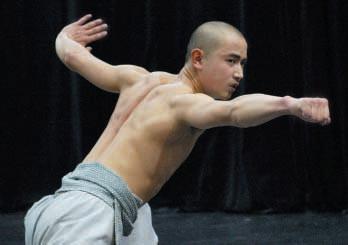
一 追捕
官兵追殺敖翔父母,父亡母抱敖翔 逃,途中聞寺廟鐘聲,將孩子棄於寺 門外逃亡。
The Ao family mother, father and infant son — are fleeing from vicious militiamen. Along the way the father dies and the mother, hearing the sound of temple bells, leaves their son at the temple door before continuing her flight.
二 日常作務
一群弟子在灑掃庭院,小敖翔在掃 地,口中喃喃地唸着:「掃地掃地掃心 地,心地不掃空掃地。」弟子練功,禪 師上堂,眾弟子參禪,禪師大喝:「你 是誰?」敖翔不明師意,以為禪師在問 自己身世。
Young disciples and the young Ao Xiang sweep the courtyard, while the latter murmurs: “Sweep the floor as well as the heart; otherwise, one sweeps in vain”. The disciples gather for a Zen session. The Master asks: “Who are you?” Ao Xiang misunderstands and thinks that the Master is asking about his parentage.
三 思母 小敖翔思母。
敖翔長大獨自練功,思母。
The young Ao Xiang thinks about his mother. A grown-up Ao Xiang practises martial arts alone, thinking about his mother.
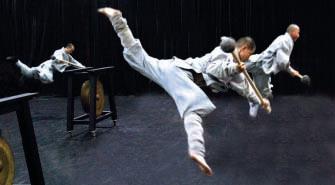
四 晨鐘暮鼓 一群弟子晨起撞鐘。
禪師上堂,弟子參禪,禪師給公案: 「你是誰?」
-中場休息-
五 幻中見母
敖翔思母,幻想見到了母陷牢獄,暗 自決定去獄中救母,禪師發現,帶弟 子下山追敖翔。
The disciples strike bells early in the morning. They gather for a Zen session. The Master raises a koan: “Who are you?”
– Interval –
Ao Xiang thinks about his mother. In a daydream he imagines her in jail and decides to save her from imprisonment. The Master discovers that Ao Xiang is missing. He leaves the mountain with the disciples to find Ao Xiang.
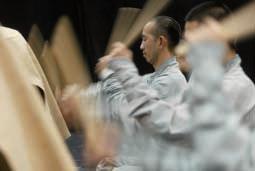
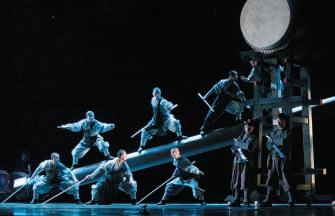
敖翔混入獄中卻遍尋不着母親,被獄
卒發現,趕忙欲逃走,捕頭與官兵緊 追而來。
七 夢中風劍
在獄中尋找不到母親,敖翔懷疑母親 早已死了,絕望沮喪與氣憤交織,逃 至半途,疲倦地睡着。他夢見許多像 禪師的人在逼問他:「你是誰?」弄不 清自己身世的敖翔,憤怒地逃離;後 又夢見真禪師出現,禪師帶着他在風 中舞棍,敖翔隨着禪師輕鬆地在風中 飛舞起來。
Searching for his mother in prison, Ao Xiang is discovered by a guard. He flees and is chased.
The Wind and Sword in a Dream
Ao Xiang reflects that his mother may no longer be among the living. Desperate and dejected, he dozes off. Dreaming, he sees many people who look like the Zen Master. They ask forcefully: “Who are you?” Having no idea of his origins, Ao Xiang leaves angrily. In another dream, Ao Xiang sees the real Zen Master ‘dancing’ with his staff in the wind. Ao Xiang follows him to dance in the wind.
八 兩刃交鋒
敖翔夢中醒來,官兵與捕頭追來,禪 師也帶着禪棒追來,官兵與弟子相遇 大打出手,敖翔與捕頭也激烈地交 戰,殺戮中互有受傷,禪師用禪棒救 了捕頭,也救了敖翔。
Waking from his dream, he sees the crowd of pursuers and the Zen Master with a staff in hand. The militiamen and the disciples engage in a battle while Ao Xiang and the Militia Captain fight ferociously. With his staff, the Zen Master intervenes and stops the fight.
九 本來面目
禪師追上敖翔,高舉禪棒直逼而來, 官兵的追殺聲也在附近,面臨生死當 下,禪師仍一棒一棒地追問:「你是 誰?」情急中,敖翔將棍揮向禪師,隨 即為自己的無禮嚇了一跳,此時他突 然聽到風的聲音,看見禪師的臉輕鬆 地微笑起來,他也輕鬆起來,敖翔順 着風在空中飛舞。
喜悅的敖翔,轉身看見捕頭拿刀向着 他,敖翔面對欲取其命的捕頭,安靜 的臉上看不出殺氣,捕頭疑惑地望着 他,兩人緊張地對峙,卻也安靜地互 望着,突然他們聽到遠方擊大法鼓的 聲音,在鼓聲中,捕頭與敖翔正式對 決。
With the militiamen approaching the Zen Master repeatedly strikes Ao Xiang asking him: “Who are you?” Ao Xiang defends himself against the blows with his staff. Astounded by his discourtesy to the Master, he suddenly hears the sound of the wind. The Zen Master looks at Ao Xiang with a peaceful smile. Ao Xiang dances in the wind.
The Militia Captain again challenges Ao Xiang, but he is tranquil. They stand ready to face off, look at each other quietly and suddenly they hear the drum from afar. They engage in battle.
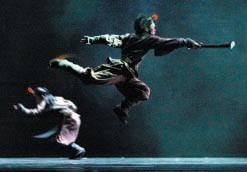
十一 尾聲
下雪天,一小沙彌拿着掃帚在雪地玩 耍,老禪師拄着禪棒慢慢走出來,此 時他們好像聽見遠遠山峰上傳來一聲 大喝:「你是誰?」小沙彌問禪師自己 的身世,老禪師微笑着用禪棒打他。
It is snowing and a young novice monk is playing around with his broom. The elderly Zen Master slowly walks out. At this time, they seem to hear a cry coming from the distant mountain peak: “Who are you?” The young novice monk asks about his parentage and the Zen Master smiles and uses his rod to strike him.
「禪」很簡單,簡單到連為它寫一篇文章都多餘。那麼《禪武不二》是 什麼?相較「禪」,「武」是容易看見的,但《禪武不二》的「武」是什 麼?「禪」既看不見,與之不二的「武」,當然也「無武」。
文:劉若瑀 《禪武不二》是個故事,也是一個公案。
有一個人不知道自己的身世,想要找出答 案,更有一群人不知道自己的「身世」想要 找出答案。每一個人都是被父母所生,即 使是個被遺棄的孤兒,蛛絲馬跡中總能找 出你是誰。但你是誰?在禪師的棒子底下 可就難了!即使找到了親生父母也發現那 不是答案。一個孤兒需要的是親情,擁有 親情的人卻要離家,拋棄親情入山尋師或 獨自遨遊。你是誰?誰是我?父母未生之 前你是誰,父母既生誰是我,參之!
跟優往常的作品一樣,《禪武不二》正是優 人生活况的公案,這齣戲像一個吸盤一
樣,從開始構想,禪的謎就一直吸引着 我,那些膾炙人口的公案,一再一再地重 複翻閱,只是︙︙古人的公案仍嘲諷着 你,而我只能繼續問,我是誰?
我是誰?公案中有許多這類的問題,《禪武 不二》就讓我們從「自己」的問題開始:
石頭希遷是唐代偉大的禪僧,一個名叫尸 利的和尚問他:「構成這個我的是什麼?」 石頭反問:「你想向我求覓什麼?」
和尚說:「如果我不問,從何處得到解答 呢?」
石頭:「難道你失去過?」
有人問圓通院的緣德禪師:「如何是我的自 己?」
緣德:「是什麼使你問這個問題?」
有人問功臣院道閑禪師:「如何是我的自 己?」
道閑答:「像你和我。」
再問:「如此就沒有二分分別了。」
道閑答:「十萬八千里!」
有人問龍華寺的得一大師:「如何是我自 己?」
答:「你是雪上加霜。」
「我是誰?」公案中禪師們各說各話,表面 上不同的解答都來自同一個明心見性的了 悟。但什麼是十萬八千里,什麼是雪上加 霜,這些令人摸不着頭緒的答案還真令參 禪者迷惑的心,雪上加霜。
《禪武不二》是一齣舞台劇,就仍是一齣舞 台劇,「舞藝何所止、迴旋入冥府」,參禪 的人都知道,這齣戲做的再好也不能徹底 解決表演者與觀眾心中的迷惑,再好的技 藝、再強的武功轉眼間也只是一片空,做 這齣戲也仍只是藝術家在自己的生命中落 於心的熱情,像武士一樣,一種生命况挑 戰「美」的力量。
哪况是「禪」呢?「優」從創團到現在都在談 「修行」談生命的道路,轉來轉去,仍在紅 塵滾滾,當然紅塵也是淨土,娑婆世界也 正是出佛之地,只是十年了。
黃誌群從印度菩提加耶回來告訴優人說: 「先打坐、再打鼓」也已經十年過了,五年
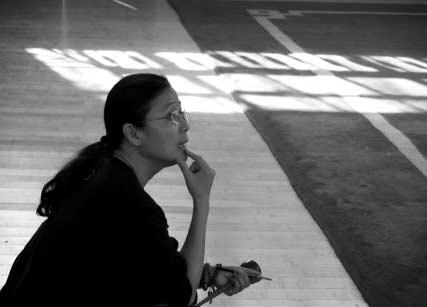
前優提出了「鼓之武」系列的創作方向,從 《持劍之心》到後來的《金剛心》、《蒲公英之 劍》到《禪武不二》,這是一個轉不出去的 「夢」,「武」正是「鼓」,鼓也是武,《禪武不 二》正是優人「先學靜坐再打鼓」的公案, 「禪」「鼓」可以不二嗎?
《聽海之心》的時代,優人雲腳台灣,白天 走路,晚上打鼓,在沒水沒電的老泉山 上,在大自然中,像「苦行僧」一樣的透過 身體的磨練來記得自己,這樣的訓練階 段,優人培養出強韌的耐力與定力。
《金剛心》是優人追尋生命道路的第二階 段,此時我與黃誌群因緣結識良師,對佛 法有更直接的信心與愛,優人在信仰的支 持中,像「僧侶」一樣對求道之路踏出如金 剛一般堅定的信念。
身體的「苦行」加上情感的信心,優人在修 行的道路上仍撥不開雲霧,《禪武不二》時 代的來臨,似乎是無所逃逸的直撲而來。
禪師的棒子在優人的腦袋上猛然敲下,這 是智慧開啟的階段。與「禪」碰撞,坐也不 是,站也不是;禮佛是錯,不敬也是錯。 此時優人從身體到情感到理智都被一一擊 潰。
優人透過「鼓藝」與「禪」對話,用「劇場」的 語言與「生命」交織︙︙
《聽海之心》、《金剛心》到《禪武不二》 一齣齣的戲在迷惑的心中編織着︙︙ 一個個的夢在舞台上追尋着︙︙ 「舞藝何所止,迴旋入冥府」,「禪武不二」 的背後仍是一個迷惑,那「明白」在哪况 呢?「明白」在哪况?好一個「明白」在哪 况。
應該是在放下「禪武不二」的時候吧!
Zen is simple, so simple that it is redundant to write about it. In that case, what are Zen and Martial Arts when they become one? Compared with Zen, the martial arts are easily visible, yet what are the martial arts when they are indivisible from Zen? If Zen is invisible and if the martial arts and Zen are as one, then surely it would be no martial arts.
by Liu Ruo-yu
ATouch of Zen is a story. It is also a koan (a paradoxical anecdote used in Zen Buddhism to demonstrate the inadequacy of logical reasoning and provoke enlightenment).
The story is about a young man who does not know his parentage and wants to find out. Everyone is born of a father and a mother, even an abandoned orphan. But who are you? The student is in trouble, under the threat of a blow from the Zen Master’s staff, if they cannot find an answer. Even when the student finds his true father and mother, he discovers they are not the answer. What an orphan needs is family love. But the one who has it, has to leave his family, relinquish the love and climb mountains to find a Master or roam the land to search for the answer to: “Who are you?” “Who am I?” Before your parents gave birth to you, who were you? Once born, who are you? Think about it!
As with previous U-Theatre works, A Touch of Zen constitutes a U-Theatre koan. This
piece of theatre is like a plant sucker. From the time it was conceived, the riddle of Zen attached itself to me and repeatedly I puzzled over various well-known koans . The koan of the ancients taunt and tantalise while I can only continue to ask: “Who am I?”
Who am I? There are many such questions among the koans. A Touch of Zen allows us to begin with the question of ‘self’.
The monk Shili once asked Shitou Xiqian, the great Zen Master of the Tang dynasty: “What does this ‘me’ consist of?”
The Zen Master responded: “Why are you asking me?”
The monk said: “If I don’t ask, how can I find the answer?”
The Zen master said: “Have you ever misplaced it?”
Someone asked the Zen Master of Gongchen monastery: “What is the ‘me’ of myself?”
The master responded: “It is like you and me.”
A further question: “In that case, then we are of no difference.”
The master answered: “Separated by 108,000 miles!”
Someone else asked the Master of Longhua Temple: "What am I myself?” His answer was: “You are snow lying atop snow.”
Who am I? a koan that each Zen Master seems to answer differently, but every response comes from the same awakened enlightenment. What actually is meant by “108,000 miles”; by “snow lying atop snow”? These enigmatic responses leave Zen seekers puzzled and confused.
A Touch of Zen is a stage production with dance artistry, whirling into the depths. Seekers of Zen will know that however good a stage production this is, it cannot completely clear up confusion in the hearts of the performers and the audience. However strong the skills, however adept the martial artistry, what remains is emptiness. Producing this stage show is but a bit of the enthusiasm that lies within a corner of the artist’s heart. As with a warrior, it is but life’s challenge to the power of beauty.
Wherein lies the Zen? Since its start, U-Theatre has been about the practice of Buddhism, about a way of life. Its ins and outs have always rolled around the red dust of Buddhist belief. Of course this red dust is virgin soil; it is out of the mundane world that Buddhism emerges.
It’s been just ten years since Huang Chihchun came back from a pilgrimage to India to tell his U-Theatre friends: “Meditation first; then comes the drumming.” Five years ago, U-Theatre produced its Drumming as Martial Arts creative series. From Meeting with Manjusri Bodhisattva to Meeting with Vajrasattva to A Touch of Zen; it has been
a dream from which one cannot awaken. The martial arts are drums; drums are the martial arts. A Touch of Zen constitutes U-Theatre’s koan of ‘first meditate; then drum’. Are not Zen and the drums indivisible?
When we were working on The Sound of Ocean , U-Theatre walked the length and breadth of Taiwan. Like wandering monks, we tested our bodies to find ourselves. This period of training developed within us enduring stamina and determination.
During the Meeting with Vajrasattva, Huang Chih-chun and I met a Master and developed a more direct faith in and love for Buddhism. U-Theatre, as trustful companions of the faith, set forth on this road.
Despite the hardships of the road and the firmness of our faith, we of U-Theatre were still unable to dispel the fog that shrouded our path to Enlightenment. It was time for A Touch of Zen; it seemed inevitable. The staff wielded by the Zen Master had crashed down on our heads. This foretold the stage when the door of wisdom was set ajar. Crashing into Zen was disquieting. To conduct rites to Buddha was wrong; not paying respects was also wrong. During this period, U-Theatre was repeatedly bludgeoned both emotionally and physically.
Dance artistry has no limits, whirling into the depths. Perplexity still lies behind A Touch of Zen . Where is understanding? Understanding, where are you? It’s time to let A Touch of Zen go!
文:焦紅波
下功夫出少林,少林功夫甲 天下。少林功夫以攻防兼 備、樸實無華、剛勁勇猛、 立足實戰的特點而名揚天下。作為少 林武術上的一朵奇葩,河南省嵩山少 林寺武術館在武學研修、教學表演、 對外交流、旅遊接待等方面始終走在 時代的前列。
2004 年11 月,台灣「優表演藝術劇團」 導演劉若瑀在遊覽少林寺武術館時, 被精湛高超的武術技藝深深吸引了: 如果將少林功夫與優劇團鼓文化結合 起來,將會是一種什麼情景?優人神 鼓是先參禪打坐,然後在寧靜中擊 鼓。優人的山,是一個集藝術與修行 於一體的場地。作為禪武發源地的少 林,也常被專家指出禪文化的挖掘力 度不夠,我也一直想在這方面尋找突 破。帶着同樣的意願,我們很快達成 了合作意向,決定將禪和武融合起 來,深入挖掘禪武文化內涵。
從此,少林寺武術館與優表演藝術劇 團開始了真誠的合作,把少林文化的 精髓「禪、拳、功、武」融入舞劇中, 巧妙地將武術動作與舒緩鏗鏘的擊鼓
by Jiao Hongbo
Shaolin is the origin of all kung fu and Shaolin kung fu is the finest on earth. Shaolin kung fu encompasses both attack and defence. Simple and unadorned, vigorous and powerful, it has a world-wide name for its ability to hold its own on actual battlegrounds. As a wonder of Shaolin martial arts, the Shaolin Wushu Training Centre at Songshan in Henan province is at the forefront of training in the martial arts, teaching wushu as a performance art, conducting international exchanges and hosting visiting tourists.
In November 2004, Liu Ruo-yu, the director of Taiwan’s U-Theatre, came to visit the Shaolin Wushu Training Centre and was strongly attracted to the consummate martial arts skills displayed there. What would be the result if Shaolin kung fu were to be combined with the drumming art of U-Theatre?
U-Theatre drummers first engage in Zen meditation before they start drumming in tranquillity. For U-Theatre personnel, their mountain is the space where they meld their art with Buddhist practice. As the birthplace of Zen martial arts, critics often comment that Shaolin has not tapped deep enough into Zen culture. I have often wanted to achieve a breakthrough in this regard. So it was that the two of us, both

結合起來,編排出了風格獨特的少林 功夫劇《禪武不二》。
為了把該劇演繹得更加完美,劉若瑀 導演先後六次來武術館交流指導,武 術館功夫隊員反覆練習、潛心琢磨, 把武術動作、語言對白、故事情節、 舞台效果等真正融為了一體。 2005 年
6 月 2 至 5 日該劇在台北國家戲劇院登 台亮相,連演四場,座無虛席。這是 「連宋」大陸之行後,海峽兩岸重要的 文化交流活動,是少林弟子與台灣演 員首次同台演出,三十多家新聞媒體 對此進行了專題報導。
《禪武不二》能榮幸地參與第三十四屆 香港藝術節演出,是該劇目繼台北國 家戲劇院演出後,在香港文藝界及亞 太地區的重大文化盛事上首次與觀眾 見面,將與世界頂級演出團體同台演 出。時間短、任務重,為此武術館與 優劇團對該劇進行了精心包裝、優 化,將少林功夫、鼓、舞三門藝術緊
密結合,更加凸顯禪武文化的內涵, 使舞台效果更加完美,以期使該劇在 國際舞台閃光。
aspiring to the same goal, very quickly decided on a cooperative venture that would bring Zen and the Martial Arts together to explore the deeper connotations of this melding.
Our collaboration, putting Shaolin culture into the theatre and mixing the martial arts and drumming together, has produced A Touch of Zen. To create this performance, Liu Ruo-yu paid six visits to Songshan to help direct and rehearse the kung fu practitioners and hone their movements, spoken dialogue, interpretation of the dramatic developments, and stage effects, so that everything was seamless.
From 2 to 5 June 2005, the production appeared on the stage of the Taipei National Theatre for four sold-out performances. This was an important cultural exchange activity across the Taiwan Straits following Lien Chan and James Soong’s visits to mainland China. It was the first time that Shaolin disciples and Taiwan actors appeared together on the same stage. More than 30 representatives of the mass media felt the event was worthy of feature articles.
A Touch of Zen now has the honour of appearing at the 34th Hong Kong Arts Festival. This will be the first time since its Taipei debut that the show will meet with audiences in a major Hong Kong and Asia Pacific region cultural event and share the limelight with other top international performing groups. Time was short and the responsibility great. For this performance there has been some meticulous polishing and packaging, so that Shaolin kung fu, drumming, and dance will mesh together to display the inner meaning of Zen martial art and to enable the show to shine more brightly on an international stage.
文:黃誌群
《禪武不二》的音樂是跟着「戲」走的, 跟以往優劇團作品最大的不同是因為 有了劇情,有了跌宕起伏的人物心 情,所以戲走到那,音樂就創作到那 兒。作品的音樂也就隨着情節,時而 描述情境、氛圍,時而渲染人物的內 心情感。
譬如,〈思母〉這段,感覺這個氛圍需 要低沉的音樂,就想到「壎」這個樂 器,「壎」又讓我想到劇中主角幼年悲 涼的身世,為了描摹這種悲涼的心 情,就又加入了琵琶,仿如幼年的敖 翔與自己對話。也因如此,這齣戲的 音樂部份,除了鼓還加入了些其他的 樂器。
另一段在主角找不到母親,向禪師問 禪也摸不着頭緒時,我選擇了用大提 琴跟笙,大提琴也有一種悲涼的感 覺,笙的加入使得低音的琴聲,在高 處飄忽,好像人走到絕路,前途茫 茫,漠然不知所措,此時會希望柳暗 花明峰迴路轉,但又遍尋不着,最後 睡着了。這樣的放鬆,使他夢見了禪 師擊法鼓的莊嚴與氣勢,將籠罩在禪 師背後的那股龐大而直截了當,無處 可逃的氣勢,直逼他而來。
在主角與禪師、捕頭三人對峙時,用 了琵琶表達當時緊張對立的張力,琵
by Huang Chih-chun
The music for A Touch of Zen followed the development of the show. The greatest difference from other U-Theatre productions was that as the drama developed, the emotions of the characters rose and fell, the music followed. The music follows the plot: now descriptive, now atmospheric, at times tinted by the inner feelings of a character.
For example, in the scene Thinking of Mother, the atmosphere called for low-toned music, so I thought of the ancient egg-shaped wind instrument called a xun. The sounds of the xun reminded me of the sad circumstances of the main character as a child. To emphasize his sorrowful feelings, I used the pipa to inject a counterpoint inner conversation between the uncaring nature of the young person and the ‘self’. This is also why some of the music in this performance used instruments other than the drum.
In another scene when the young man cannot find his mother and advice from the Zen Master only confuses him, I chose the sound of the double bass together with the sheng. The bass sound has a certain melancholy, and with the sheng floating above it, it’s as if someone is bewildered walking along a road to ruin where the future is murky and he doesn’t know how to proceed. He wishes that the path would take a turn for the better, but this doesn’t happen and finally he falls asleep. This release allows him to dream of the solemn and atmospheric sound of the Zen Master’s drumming which beats to dispel the enveloping mists and lights the way forward.
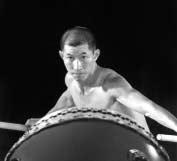
琶是一把很有「彈性」的樂器,它既可 以在〈思母〉中呈現出柔腸寸斷,也可 以在比武時凝塑肅殺的氣勢及武人剛 烈的特質。
這些音樂的旋律來源,是導演在少林 寺武術館跟少林弟子排練時,當場為 了給演員「心情」時吟唱出來的,我再 根據她唱的旋律來變奏發展。
在《金剛經》况有一首四句偈:
一切有為法 如夢幻泡影
如露亦如電 應作如是觀
有一次我們在少林寺武術館排練時帶 弟子們唸《金剛經》,當他們唸到這句 時,我心中突然冒出了這四句偈的旋 律,就把它用在〈日常作務〉與〈晨鐘暮 鼓〉這兩段中。這旋律出現時,心中有 一種安定的力量,也有一種打開自 己,大闊闊往前敞開的心情,並逐字 逐句將詩偈吟誦出來。
在小沙彌灑掃庭院這段則用了木琴跟 鑼鼓的結合,營造出寺院日常作務輕 鬆有趣的一面,武術館的小沙彌,武 功高強地蹦來蹦去,看他堅毅的神情 又不脫稚氣,配上這首旋律特別有 趣。
When the protagonist, the Zen Master and the pursuers face one another, the pipa conveys the tension of the confrontation. The pipa is a very flexible instrument; it can convey the anguish of someone thinking of his mother, but it can also express the tension of a battleground or the ferocious tenacity of a fighting man.
The origins of the melodies are derived from the sounds made by the director in rehearsal with the disciples of the Shaolin Temple Wushu Training Centre. I took the sounds chanted and developed them into melodies.
The Diamond Sutra includes these four lines: All is for the dharma
Ephemeral as a dream
Like dewdrops; like lightning
The answer seems clear
When we were rehearsing at the Shaolin Training Centre, we led the disciples in reciting the sutra. When they came to these four lines, four melodic phrases popped into my mind. I used them in two scenes: Daily Routine and Bells at Sunrise, Drums at Sunset. When this melody appears, so also does a surge of inner tranquillity that also opens up the self to a sense of the future.
In the scene when the young novices are sweeping the courtyard, the sound of the xylophone is combined with the gong and drums to create a light-hearted amusing scene of the daily routine of monastery life. The agile young novices, already adept at martial arts, tumble here and there. Their determined yet youthful movements accompanied by these melodies create an interesting performance.
The tune that has particularly caught the audiences fancy is The Wind and Sword in a Dream, scored for the piano. I have been playing the drums since childhood, but only took up the piano five years ago, yet it was love at first sight. Although my technique may be lacking, perhaps because it is also played with the hands, I feel it too is a percussion instrument. I often play the
這次在《禪武不二》况最為觀眾驚豔的 曲子是〈夢中風劍〉,是用鋼琴譜的 曲,從小擊鼓的我,五年前才開始摸 鋼琴,卻也對它一見鍾情,雖沒有高 度的技巧,也許是因為也用手來彈, 對我來說好像是另外一種敲擊樂,常 常隨手拈來也在家中彈琴自娛,後來 用電腦作曲,音樂在其中,隨興所 至,手不能彈,但腦中複雜的旋律就 煩勞電腦作曲,卻也彌補了成年後學 琴的缺憾。〈夢中風劍〉的旋律也是《禪 武不二》况,表達「禪」的意境的曲子, 有似空非空,提不住留不下,無可捉 摸卻也一直縈繞的力量。
回想起來,這些音樂都不是事先想好 的,看着若瑀戲走那兒,曲子就編到 那兒,無需絞盡腦汁,也沒有什麼預 設立場,反而因為不斷冒出的靈感而 常常熬夜完成曲子,就這樣,戲排完 了,曲子也全編完了。
這次的鼓曲,〈追捕〉和〈劫獄〉,因為 主題明確,團員的掌握也比以前快和 準,大多數時間反而是花在要和少林 寺武術館弟子們發展的部份,花最多 時間排練的是〈晨鐘暮鼓〉和〈禪武不 二〉,因為要將僧袍的長袖配上身體動 作,編入曲中的節奏,而武術館的弟 子功夫非常好,卻沒有經過音樂訓 練。然而將武術融入節奏,是這次和 少林寺武術館合作最主要的初衷,而 且這些弟子也非常認真,年紀輕且有 很大的潛力。自己從小練武,將武術 的身體融入音樂,一直是我心中強烈 的夢想,從《聽海之心》到《持劍之 心》,都是階段性的發展。最後一首 〈禪武不二〉非但將武術與音樂結合, 還要加上戲劇性的公案穿插其中,確 實困難許多,但也樂趣無窮啊!
piano at home for my own amusement. Later I started using the computer to compose music. The music lies within the computer and there is no need for my hands to play it, but the complex melodies in my brain ask the computer to compose the music and also to make up for the deficiencies in my late-acquired and faulty piano-playing. The Wind and Sword in a Dream is the tune that expresses the concept of Zen in A Touch of Zen — empty yet not empty; too heavy to lift yet too light to keep down; unobtainable yet ever present.
On reflection, none of the music was preconceived it emerged in the footprints of the plot without the need to do too much thinking. The inspiration that ceaselessly poured out meant that as the music emerged I spent many sleepless nights creating the score. Thus it was that when the show was ready, so was the music.
The theme of the drum tunes Pursuit and Breaking into Prison were so clear that the musicians were faster and more precise in grasping them, so that most of the time was spent in working with the disciples of the Shaolin Training Centre. The majority was spent in rehearsing Bells at Sunrise, Drums at Sunset, and Zen and Martial Arts to incorporate the sleeve movements of the monks’ robes with the rhythms of the music. While the disciples had excellent kung fu ability, they had never undergone any training in music. However, setting the martial arts to a beat was the original intention of cooperating with the Shaolin Training Centre. The disciples were young, earnest and had great potential.
I have practiced the martial arts from a very young age and to incorporate music with martial arts has always been a very strong dream of mine. From The Sound of Ocean to Meeting with Manjusri Bodhisattva is but a matter of development. The final A Touch of Zen tune not only brings the martial arts and music together, it also incorporates the dramatic nature of the koan. There were many difficulties, but, oh, the pleasure was infinite!
2002 年的冬天,優劇團受邀到英國巴 比肯中心演出《聽海之心》。《泰晤士 報》的劇評,用「禪與敲擊樂藝術」來形 容這個已經在十六國巡迴超過一百場 的演出。
2006 年初春,優劇團和「河南省嵩山 少林寺武術館」把《禪武不二》搬上香港 藝術節舞台。表演者不但以劇情的鋪 陳來說一個簡單的故事,形式上,優 人更和少林武術弟子將武術和擊鼓融 合起來。
因為焦紅波館長領導的少林寺武術館 加入,《禪武不二》武術底蘊的紮實, 不言而喻;因為劉若瑀和黃誌群長年 致力擊鼓和劇場的結合,這次作品所 透露的「禪」的意境,也許可以讓我們 以「禪與劇場藝術」來形容它。
武術的訓練,經年累月,修身修心。 武術的展現,靜若處子,動如脫兔。
劉若瑀和黃誌群從前年冬天,六進六 出嵩山少林寺武術館進行排練。造訪 武術館三次的我,跟這兩位創作者一 樣,對於少林功夫弟子精氣神所表現 出來的能量之高,讚嘆不已。
然而,走上舞台的所有藝術創作,都 需要形式來規範。舞蹈演出中的舞 者,如果將之比擬為音樂,他們會是 呈現音符的樂器;比擬為文學,他們 會是振筆疾書而成的文字。樂器需要 指揮統合,文字需要作家揮灑。精采 的武術和動人的擊鼓在舞台相遇,創 作者和表演者的工作都相當關鍵。
去年六月,《禪武不二》在台北首演。 少林功夫弟子的硬底子武術風采,讓
by Lee Li-heng
In the winter of 2002, U-Theatre was invited by the Barbican Centre in London to stage The Sound of Ocean . A review in The Times described the show as “Zen and the art of percussion”.
At the 2006 Hong Kong Arts Festival, U-Theatre and the Shaolin Temple Wushu Training Centre at Songshan, Henan province, jointly present A Touch of Zen . Not only have the performers unfolded the drama of a simple story, U-Theatre and the Shaolin disciples further fused martial arts and percussion music.
Needless to say, with the participation of the Shaolin Temple Wushu Training Center under its director Jiao Hongbo, there is a firm grasp of the intricacies of the martial arts in A Touch of Zen. Because both Liu Ruo-yu and Huang Chihchun have long worked on amalgamating theatre with percussion, the revelation of the meaning of Zen in the present production could be described as Zen and the art of theatre.
Year after year of martial arts training hones the body and refines the spirit. What emerges from the practice of martial arts is both tranquillity and agility. Since the winter of 2004, Liu Ruoyu and Huang Chih-chun travelled to Songshan six times, to oversee rehearsals. I have been there only three times and have nothing but praise for the skills and spirit shown by the Shaolin disciples.
However, all artistic creations that are put on stage must have structural form. The dancers, if compared to music, are the instruments that give voice to the stave notes. If compared to a
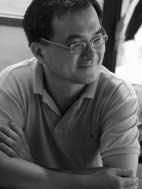
許多觀眾掌聲連連。優人的擊鼓和整 體音樂呈現,也吸引了大家的目光。
不過,就像所有重要作品首演之後, 都會面臨評論界觀眾希望修改精進的 呼聲一樣,《禪武不二》二度進劇場, 編導劉若瑀也花了極大的功夫來進行 修編的工作。二度搬演《禪武不二》, 劉若瑀將劇中意境拔高至集中凸顯「你 是誰?」這個命題。
龐雜的劇情枝蔓被大刀修剪,同時增 加武術和擊鼓的同台演出。少林功夫 弟子神乎其技的功夫,沉穩有序地展 現出來。拳術、兵器對打和基本功, 在香港弟子馮國基和曾文通的燈光與 舞台設計下,變得既現代又傳統。這 部份的表現,讓我們對於少林武術走 向世界劇場的可能成就,益加有信 心。優人的鼓藝和長年靜坐所磨練出 來的氣質,則讓人眼睛更加為之一 亮。
將武術的形體和技巧,結合擊鼓與音 樂和場面調度,讓只能意會的「禪」, 在劇場變得可看可親。《禪武不二》正 在進行華人劇場的一場大膽實驗,少 林寺武術館和優劇團的朋友,已經像 「過河的卒子」一樣,只能向前,而且 只想向前。
現在,禪與鼓與武的相遇,需要觀眾 的投入和創作者的反思才能更圓滿。
piece of literature, they are the pens and brushes that form the words. Musical instruments need a conductor to bring them together; words need a writer to show off their worth. When exciting martial arts and moving percussion sounds come together on the stage, creators and performers are of mutual importance.
Last year in June A Touch of Zen had its debut in Taipei. The martial arts displayed by the disciples of Shaolin kung fu and U-Theatre’s drumming and music inspired great applause. However, as with all major works, a spate of calls for revisions came from the critics. The reworked A Touch of Zen takes its artistic concepts to new heights and brings the theme of “Who are you?” into greater prominence.
The grandly complex story has had its extraneous branches trimmed off, and more scenes added where the martial arts and the drums appear together. The spirit behind the skill of the Shaolin disciples was deliberately and systematically highlighted. Hand-to-hand combat and arms clashes seem both modern and traditional under the lighting and stage designs of Hong Kong’s Gabriel Fung and Tsang Man-tung. This aspect gave us greater confidence that the achievements of the Shaolin martial arts would advance into world theatres.
By fusing the form and techniques of the martial arts with skilled drumming, suitable music and fine sets, the sense of Zen was transformed into something visible and approachable. A Touch of Zen is engaged in a bold experiment of Chinese theatre. Like chess pieces that have passed beyond the point of no return on the board, our friends in the Shaolin Wushu Training Centre and in U-Theatre can only move forward and, in fact, only think of advancing.
Today, this meeting of Zen, drums and martial arts calls only for reflection by the audience and the creators to round things off nicely.
優表演藝術劇團
「優」在中國傳統戲曲的意思是「表演者」。
結合「道」與「藝」的表演藝術團體
在熱鬧繁華的台北城另闢一方寧靜、擁有一座山的優劇團,由劉若瑀與黃誌群於木柵老泉 山上創立了「優人神鼓」。藝術總監劉若瑀傳承自波蘭劇場大師果托夫斯基在山林中接受專 業訓練的方法,使她非常注重表演者的訓練與身體能量的開發,決定以「一個表演者身心 的開發」為重心。
1993年邀約黃誌群擔任擊鼓指導,「以先學靜坐,再教擊鼓」的方式,從 此奠定了劇團的訓練及表演形式。
優人在山上打太極、練武術與擊鼓,比一般表演藝術工作者流了更多的汗水,卻多了耐 力、體力與純淨的心靈。像一個修行者般的靜坐,透過「靜坐」的自我觀照,在擁擠紛亂的 世界中維持內心的寧靜,他們相信這份寧靜可以透過舞台上的表演與現場的觀眾,共同凝 聚一個「活在當下」的片刻。
在自己的寧靜中擊鼓 優人神鼓自1988 年創團迄今,致力呈現最精緻的藝術品質,堅持走出一條結合「道 追 尋生命根本的意義」與「藝 生活美學的實踐」的表演之路。曾受邀至歐美許多重要的國 際藝術節演出,於 1998 年以《聽海之心》受到法國《世界日報》評為法國亞維儂藝術節最佳 節目,以及 2000 年法國里昂舞蹈藝術節最受觀眾歡迎的節目; 2003 年 8 月,在德國柏林 藝術節表演廳,也以《聽海之心》感動了柏林人,被喻為「這個星期最讓柏林人靈光乍現的 表演節目」。
此外, 2002年度作品《金剛心》,榮獲「第一屆台新藝術獎 表演藝術類首獎」,來自評 審的讚譽是:「透過簡潔樸素的舞台,傳達動中有靜、靜中有動的境界,是一個視覺、聽 覺與表演的獨特融合,並富有整體性的表演藝術傑作。」在國內外均受到高度的讚譽。
雲腳
走路,是優劇團獨特的肢體訓練方式。
走路,讓優人走出劇場空間與有情眾生相知相遇。
在日復一日的行走中,優人們學習放鬆意念,將心性回歸到簡單與寧靜。
1996 年,優人《用腳親炙大地》以走一天路打一場鼓的方式鍛煉自我,他們白天行腳於台 灣西部二十五個鄉鎮,晚上則在廟口和當地的表演團體共同演出。
1997 年,優人們再度以三十五天時間行走於台灣東部山區,晚上則和台灣九大原住民族 共同分享他們的祭儀樂舞。
2002 年,優人們遠赴西藏神山岡仁波齊峰,藉轉山為世人祈福。
2004 年,優人將雲腳路線延伸到巴黎,藉雲腳感受土地豐沛的能量與有情眾生相遇。
無論在國際上或是自己的土地上,優人神鼓一本初心,希望透過鼓聲帶給世人平靜安詳。
U means performers in Chinese traditional opera. Thus, U symbolises performers who continue from ancient times to the modern day.
U-Theatre was founded by Liu Ruo-yu, its present artistic director, in October 1988. She studied theatre at New York University, and also attended professional workshops led by the Polish master Jerzy Grotowski. When she returned to Taiwan, she immediately decided to make the training of U-performers her goal and to dedicate herself to the exploration of the body and mind of the performers. To reach this goal, she founded U-Theatre on Laochuan Mountain on the outskirts of Taipei.
In 1993, Liu invited Huang Chih-Chun, a traditional Chinese percussionist with nearly 20 years experience, to teach U-Theatre members drumming. It was Huang’s deepheld conviction that ‘to learn to play the drums, one must first learn meditation’, that inspired the adoption of meditation, and later, Chinese martial arts, into the core curriculum of U-Theatre training. Drumming and meditation, together with theatre, have since become essential elements of all U-Theatre performances, and constitute their unique performing style.
“Performance is the representation of the best aspects of life” is Liu’s oft-repeated mantra. The attention that U-Theatre places on improving the quality of life and its expression through theatre makes U-Theatre unique among modern theatre groups.

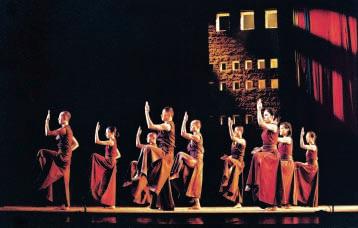
Other than performing at its own theatre in the mountains, U-Theatre also performs at outdoor theatres in the countryside, and at theatres and cultural centres in cities all over Taiwan. In addition to this, U-Theatre is frequently invited to tour abroad. In the summer of 1998, the Festival d’Avignon opened its natural quarry, the Carrière Boulbon, to stage U-Theatre’s momentous, 10th anniversary creation, The Sound of Ocean . Since then, U-Theatre has been invited to perform and take part in important festivals in the US, France, Germany, the Netherlands, Belgium, Italy, Spain, Switzerland and Norway. Further international tours have been scheduled well into 2006.
On the whole, the U-Theatre’s performance features a combination of music, martial arts and dramatic elements. The purpose is to present an epic scope and an overpowering theatrical ambience for the audience. In addition, the ‘humble walks’ that the U-Performers have taken all over the world are intended to reconnect the U-Performers’ with the land. Meditation and tai-chi, on the other hand, help the U-Performers garner the greatest inner power so that they can get rid of external constraints and return to a selfless state. In this way, while conducting martial arts, striking the drum or the gong, the U-Performers will be able to draw on their most primitive energies. Thus, in the midst of roaring drumbeats, a therapeutic purging force is born. This is the state of ‘having dao and art in one’ that the U-Theatre has long sought to achieve.
U-Performers have honed their artistic and spiritual skills in their mountain workshop over many years now. They lead simple lives, which are fully reflected in the unique works they have developed. The members of U-Theatre are resolute in their commitment to continue facing their lives with honesty and pursing inner peace.
河南省嵩山少林寺武術館
河南省嵩山少林寺武術館位於千年名剎 嵩山少林寺東側 700 公尺,武術館是由中國 國家旅遊局和河南省人民政府共同投資興建的第一所海內外招生,培養少林武術專業人 才,傳授少林武術,集旅遊、接待為一體的綜合性少林武術培訓基地。
武術館佔地面積 25,000平方公尺,建築面積 15,000平方公尺,內有四百餘座位的現代化 表演廳一個,練功房2 個,室內傳統練功場一個。少林武術賓館(外國學員綜合服務區)是 少林寺景區惟一一家星級涉外酒店。教學設施一流,環境條件優越,為一流的武術訓練和 武術文化旅遊中心。
武術館擁有三個技藝精湛、功夫硬的少林功夫表演團,承擔着國際、國內的武術教學和表 演工作。建館近二十年來,先後向數百萬中外遊客展示精湛的少林功夫,數以萬計來自世 界各地的武術愛好者前來研修少林功夫或歸宗朝聖。
武術館曾應邀到六十餘個國家和地區進行表演、教學和文化交流,是首家進入奧地利金色 大廳和目前惟一在英國皇家劇院表演的中國文化團體,並受到法國總統希拉克和奧地利議 長、波里尼西亞總統等國家政要的熱情接待。
該館主要內設機構有少林武術賓館(禪居酒店)、少林武術旅行社、河南少林武術學院、國 際教學培訓中心、國際表演部、寶劍廠、廣告部。主要職責包括接待外國政府代表團及民 間友好團體,培訓海內外少林武術專業人才,整理少林武術傳統項目,開展少林武術文化 交流。
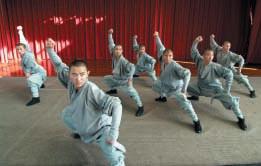
The Shaolin Temple Wushu Training Centre is located 700 metres to the east of the long established and noted Shaolin Temple at Songshan in Henan province. The building of the Centre, the first to accept students from China and abroad, was financed jointly by the National Tourism Bureau and the Henan Provincial Government to nurture martial arts talents, ensure continuity of the martial arts, attract tourists and establish a training ground for a comprehensive span of the martial arts.
The Centre covers 25,000 square metres, of which 15,000 square metres has been built upon. It has a performance hall that seats over 400 spectators, two practice halls and an indoor training arena, a workshop to forge swords and a travel agency. The Shaolin Wushu Guest House, which is an all-purpose area for students from abroad, is the only starred hotel in the Shaolin Temple area. The publicity department responsibilities include the reception of representatives of foreign governments and friendship groups, the training of Chinese and foreign Shaolin martial arts experts, the organisation of traditional Shaolin martial arts events and the promotion of Shaolin martial arts cultural exchanges. It is truly a first-class martial arts training centre and the focus of cultural tourism for the martial arts.
The Centre has three highly skilled performing groups that take on the work of teaching martial arts and performing throughout the country and abroad. In the almost 20 years that the Centre has existed, millions of visitors have come on pilgrimages or to witness the kung fu of Shaolin. The groups have also been invited abroad to perform, teach or engage in cultural exchanges in more than 60 regions and countries. It was the first Chinese cultural group to have performed in Austria’s Musikverein and the only one to have performed in the National Theatre in London. It has also been received warmly by such national leaders as France’s President Chirac, the head of Austria’s National Assembly and the Polynesian Head of State.
劉若 Liu Ruo-yu
藝術總監/導演/編劇 Artistic Director, Director and Scriptwriter
劉若瑀本名靜敏, 1980 年代初為蘭陵劇坊主要演員, 1983 年赴美國紐約大學戲劇研究所深造 並獲劇場藝術碩士學位,隔年經遴選得以參加由波蘭劇場大師果托夫斯基所領導的一年工作 坊。親炙大師的工作經驗,使劉若瑀視劇場本質的深度追求為藝術工作的首要原則。
劉若瑀回台灣後,於 1988 年創立「優表演藝術劇團」,先由民間祭儀和民俗演藝的學習入手, 接着融合太極導引與演員身體能量開發的訓練。她深信那是一種「重新認識自己」的過程。 1993 年,邀請黃誌群加入劇團,合創「優人神鼓」,嘗試將擊鼓靜坐和武術融入劇場創作。 1997 年與黃誌群合作的《聽海之心》於法國阿維儂藝術節演出後,巡迴世界十數國演出上百 場, 2002 年與黃誌群編作的《金剛心》,榮獲同年「第一屆台新藝術獎 表演藝術類首獎」, 2003 年《蒲公英之劍》是劉若瑀首部原著劇本改編劇作,並同步出版同名繪本。
After a period in the early 1980s as a principle actor with the Lan Ling Theatre Workshop, Liu began studies in 1983 for a Master of Arts degree at New York University. Two years later she was chosen to take part in a year-long Jerzy Grotowski workshop, which led her to an abiding interest in the underlying principles of drama.
After returning to Taiwan, Liu formed U-Theatre in 1988. The interest of the Theatre was initially directed towards popular ritual ceremonies and folk performing arts. She later introduced tai chi exercises and physical training for the Theatre’s performers in the strong belief that these were part of the process of awakening the self. In 1993, she invited Huang Chih-chun to join the company and brought together drumming, meditation and martial arts. In 1997 The Sound of Ocean, jointly created with Huang Chih-chun, was presented at the Festival d’Avignon and then toured, giving over 100 performances in more than 10 countries. In 2002 Meeting with Vajrasattva, which she again created with Huang, won First Prize at the inaugural Taiwan New Arts Awards. In 2003 The Dandelion Sword was Liu’s first presentation adapted from her own script, which was published simultaneously with the stage production.
武術總策劃 Wushu Chief Producer
焦紅波, 1962 年生於河南省登封市,少林十八金剛,中國武術七段,國家一級教練,中國武 術學會少林拳研究會副會長,任職新加坡、馬來西亞檳城、比利時等多國城市的國術機構。
自1970 年開始武術專業生涯以來,焦紅波屢獲榮譽,包括河南省首屆散打大賽金牌獎;第五 屆全運會優秀獎;第五屆歐洲武術節「功夫金像獎」及「友誼和平獎」。焦紅波注重傳統武術的 挖掘與整理,並與北京體育大學門慧峰教授合編《少林武術教材》一書。
在過去七屆中國鄭州國際少林武術節中,焦紅波負責編排大型武術表演節目,此外,他曾率 領少林功夫表演團出訪日本、美國、英國、澳洲等六十多個國家和地區。
Born in Dengfeng city in Henan province, Jiao Hongbo is among China’s top ranked martial arts instructors. He is deputy chairman of the Shaolin style martial arts society of the Chinese Wushu Association and holds offices in Chinese martial arts organisations in several countries including Singapore, Malaysia and Belgium. Since he began his professional martial arts career in 1970, Jiao has received many honours. They include a Gold Medal at the inaugural Henan Provincial Freestyle Competition, a Medal of Honour at the 5th China National Games and two medals at the 5th European Martial Arts Festival. He has conducted considerable research into traditional martial arts, and is co-author of the Shaolin Wushu Syllabus with Professor Men Huifeng of the Beijing Sports University. Over the past seven years, Jiao has organised large-scale wushu programmes for the Chinese Zhengzhou International Wushu Festival. In addition, he has led several Shaolin kung fu performing groups to more than 60 countries and regions including Japan, the US, the UK and Australia.
黃誌群 Huang Chih-chun
音樂總監/演出 Music Director and Performer
黃誌群原名志文, 1965 年生於馬來西亞,六歲開始學習擊鼓,十歲正式拜師學習中國武術, 浸淫在武術與擊鼓的世界超過二十年。
曾加入台北民族舞團及雲門舞集,隨團巡演多國。 1993 年初次到印度,學習靜坐及領悟「活 在當下」的智慧,從此多次進出印度與西藏。同年受劉若瑀之邀,擔任優表演藝術劇團「擊鼓 指導」,以「先學靜坐,再習擊鼓」的方式,奠定了優人以擊鼓與武術的表演形式基底。黃誌群 認為表演和打坐時的境界一樣的,都是「活在當下」。他說:「表演不是向外投射的力量,而是 內在自我的探尋。」
從 1997 年的《聽海之心》、 2002 年《金剛心》到 2003 年的《蒲公英之劍》,都是黃誌群編曲創作 的作品,他擅用生活中細微觀察的聲響,融合呈現於舞台之上,展現出多元的音樂形式及飽 滿的能量,不但震懾人心,並多獲讚賞。
在2005 年劇作《禪武不二》,首度擔任作曲,創作配合戲劇張力的音樂,音樂性更勝以往,呈 現多元的樣貌。
Born in Malaysia in 1965, Huang Chi-chun studied drumming from the age of six and martial arts from age 10.
As a member of the Taipei Folk Dance Company and the Cloud Gate Dance Theatre, he has toured many countries. In early 1993, he travelled to India to study meditation and the wisdom behind ‘living here and now’. Since then he has become a frequent visitor to India and Tibet. Also in 1993 he was invited by Liu Ruo-yu to instruct U-Theatre performers in drumming and meditation in order to set the foundation for U-Theatre’s style of integrating drums with martial arts. Huang sees the realm of performance as being no different from meditation both ‘living here and now’. He believes that “performing is not a strength directed outwards; it's a search within the self”.
The Sound of Ocean in 1997, Meeting with Vajrasattva in 2002 and The Dandelion Sword in 2003 all used music composed by Huang Chih-chun. He likes to use the sounds heard through careful everyday listening and to integrate them with what appears on the stage. For A Touch of Zen , his music provides dramatic intensity complementing the story.
馮國基 Gabriel Fung
燈光設計 Lighting Designer
馮國基香港演藝學院畢業後,即投入舞台工作至今。作品領域包括舞蹈、戲劇、歌劇、戲曲 等。近期作品包括「新視野藝術節 2004」之節目:進劇場《象從不遺忘》及梅卓燕《流蓮歡》;
劇場組合與新域劇團聯合製作之《虎鶴相形》,以及城市當代舞蹈團黎海寧編導的《畸人說 夢》。
馮國基 2003 年獲香港舞蹈聯盟舞蹈年獎及香港戲劇協會舞台劇獎的最佳燈光設計獎。
Since graduating from the Hong Kong Academy for Performing Arts, Gabriel Fung has been working in theatre, dance and opera. His recent work has been for the 2004 New Vision Arts Festival; e never forgets (Theatre du Pif), the dance show lot-us for Mui Cheunk-yin, Of Minds and No-mind (Theatre Ensemble and Prospects Theatre Company) and The Comedy of K (City Contemporary Dance Company).
In 2003, Fung won an award from the Hong Kong Dance Association and the Best Lighting Design of the Hong Kong Drama Society.
舞台設計 Set Designer
曾文通 1997 年於香港演藝學院畢業,主修舞台及服裝設計,重要設計作品有劇場組合的《兩 條老柴玩遊戲》,獲第九屆香港舞台劇獎之最佳舞台設計獎;另憑《墮落鳥》獲第十一屆香港舞 台劇獎之最佳服裝設計獎。
2002 年,曾文通獲邀為香港大會堂成立四十周舉行舞台設計展覽「舞台空間消解構成」,展出 具代表性的作品,其後更巡迴東京、北京、台北及澳門等地。
曾文通曾為香港演藝學院、中國戲劇家協會,以及中港多間大學,策劃及主持戲劇、舞台設 計、裝置藝術、創意繪畫等工作坊。
Tsang Man-tung graduated from the Hong Kong Academy for Performing Arts in stage and costume design. One of his most important design projects was for the complex multi-media theatrical work The Game, for which he won the Best Stage Design Prize in the Hong Kong Theatre Awards. His work for The Blue Bird won the Best Costume Prize in the 11th year of the same awards.
In 2002, to celebrate the 40th anniversary of the opening of the Hong Kong City Hall, Tsang was invited to stage a set design exhibition which incorporate representative work he had created over the previous five years. The exhibition subsequently travelled to Tokyo, Beijing, Taipei and Macau.
Tsang has held workshops on stage design, the decorative arts and other arts subjects for many universities and performance companies in China and Hong Kong.
霍榮齡 Huo Jung-ling
服裝設計 Costume Designer
霍榮齡為台灣國立藝專美工科畢業, 1980 至2005 年間,曾為文建會、國家戲劇院、台北市文 化局、新舞臺、雲門舞集等多個政府部門及藝術團體單位開創平面設計,以及擔任《聯合文 學》、《聯合晚報》、《台北人》等多本雜誌的平面媒體創刊及美術設計。
霍榮齡曾為多部蘭陵劇坊製作、許惠美舞蹈社、教育部青少年民俗歐洲訪問團及大專院校美 洲青訪團、電視劇及日本攝影家藤井秀樹「中國女子」系列擔任服裝造型設計。
A graduate of the National Taiwan Institute of Art, Huo Jung-ling worked from 1980 to 2005 on design projects for various government departments and arts groups as well as for magazine publications.
She has designed costumes for many Lan Ling Theatre productions as well as for the Hsu Hui-mei Dance Society; various Department of Education tours to Europe and the Americas; television dramas; and Japanese photographer Hideki Fujii’s ‘Chinese Women’ series.